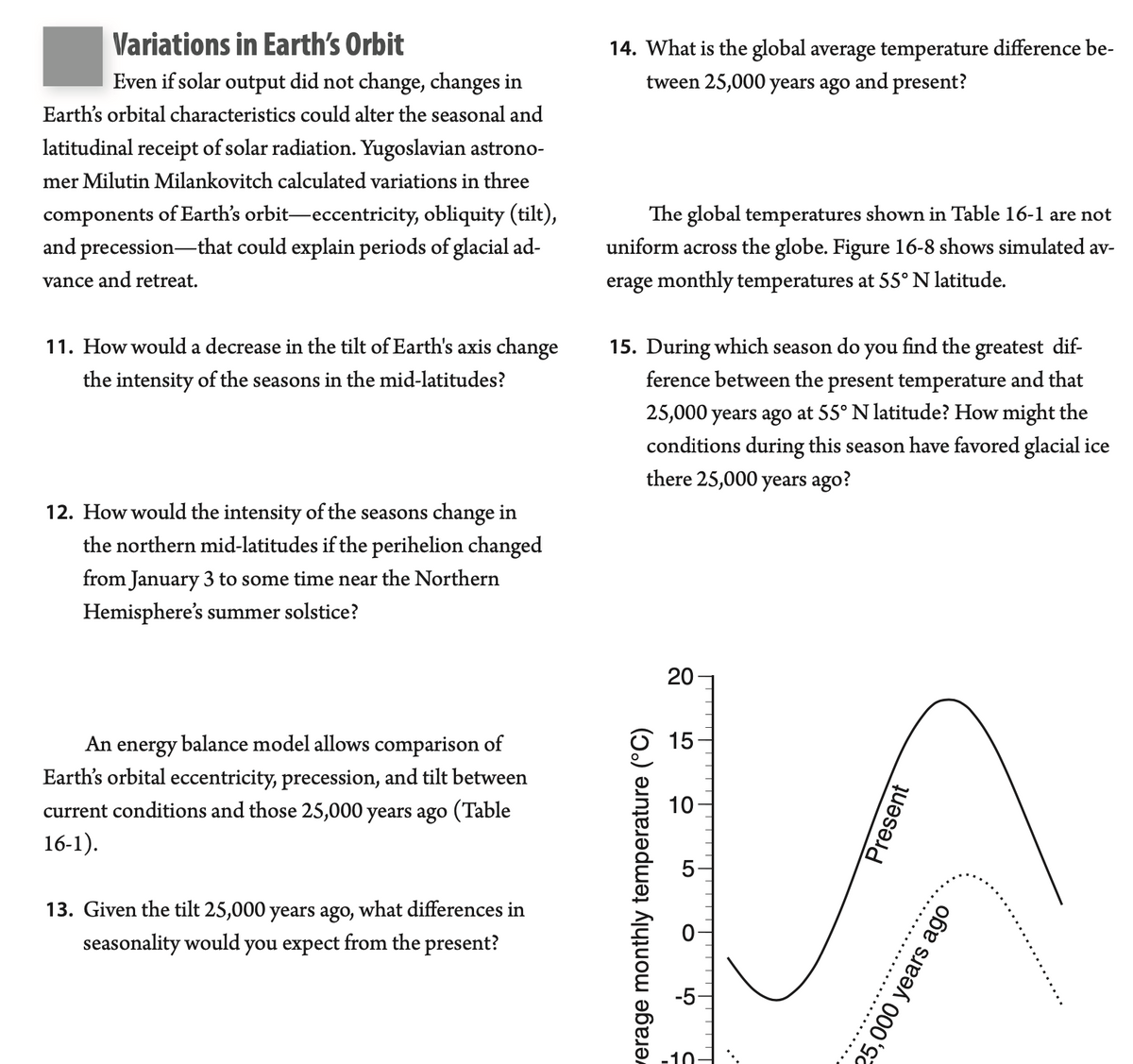Variations in Earth's Orbit Even if solar output did not change, changes in Earth's orbital characteristics could alter the seasonal and latitudinal receipt of solar radiation. Yugoslavian astrono- mer Milutin Milankovitch calculated variations in three components of Earth's orbit-eccentricity, obliquity (tilt), and precession-that could explain periods of glacial ad- vance and retreat. 11. How would a decrease in the tilt of Earth's axis change the intensity of the seasons in the mid-latitudes? 12. How would the intensity of the seasons change in the northern mid-latitudes if the perihelion changed from January 3 to some time near the Northern Hemisphere's summer solstice?
Variations in Earth's Orbit Even if solar output did not change, changes in Earth's orbital characteristics could alter the seasonal and latitudinal receipt of solar radiation. Yugoslavian astrono- mer Milutin Milankovitch calculated variations in three components of Earth's orbit-eccentricity, obliquity (tilt), and precession-that could explain periods of glacial ad- vance and retreat. 11. How would a decrease in the tilt of Earth's axis change the intensity of the seasons in the mid-latitudes? 12. How would the intensity of the seasons change in the northern mid-latitudes if the perihelion changed from January 3 to some time near the Northern Hemisphere's summer solstice?
Applications and Investigations in Earth Science (9th Edition)
9th Edition
ISBN:9780134746241
Author:Edward J. Tarbuck, Frederick K. Lutgens, Dennis G. Tasa
Publisher:Edward J. Tarbuck, Frederick K. Lutgens, Dennis G. Tasa
Chapter1: The Study Of Minerals
Section: Chapter Questions
Problem 1LR
Related questions
Question

Transcribed Image Text:Variations in Earth's Orbit
14. What is the global average temperature difference be-
tween 25,000 years ago and present?
Even if solar output did not change, changes in
Earth's orbital characteristics could alter the seasonal and
latitudinal receipt of solar radiation. Yugoslavian astrono-
mer Milutin Milankovitch calculated variations in three
components of Earth's orbit-eccentricity, obliquity (tilt),
and precession-that could explain periods of glacial ad-
The global temperatures shown in Table 16-1 are not
uniform across the globe. Figure 16-8 shows simulated av-
vance and retreat.
erage monthly temperatures at 55°N latitude.
11. How would a decrease in the tilt of Earth's axis change
15. During which season do you find the greatest dif-
ference between the present temperature and that
the intensity of the seasons in the mid-latitudes?
25,000 years ago at 55° N latitude? How might the
conditions during this season have favored glacial ice
there 25,000 years ago?
12. How would the intensity of the seasons change in
the northern mid-latitudes if the perihelion changed
from January 3 to some time near the Northern
Hemisphere's summer solstice?
15
An energy balance model allows comparison of
Earth's orbital eccentricity, precession, and tilt between
current conditions and those 25,000 years ago (Table
16-1).
10
13. Given the tilt 25,000 years ago, what differences in
seasonality would you expect from the present?
-5-
обе
..........................
verage monthly temperature (°C)
Present
20
Expert Solution
This question has been solved!
Explore an expertly crafted, step-by-step solution for a thorough understanding of key concepts.
This is a popular solution!
Trending now
This is a popular solution!
Step by step
Solved in 2 steps

Recommended textbooks for you

Applications and Investigations in Earth Science …
Earth Science
ISBN:
9780134746241
Author:
Edward J. Tarbuck, Frederick K. Lutgens, Dennis G. Tasa
Publisher:
PEARSON

Exercises for Weather & Climate (9th Edition)
Earth Science
ISBN:
9780134041360
Author:
Greg Carbone
Publisher:
PEARSON

Environmental Science
Earth Science
ISBN:
9781260153125
Author:
William P Cunningham Prof., Mary Ann Cunningham Professor
Publisher:
McGraw-Hill Education

Applications and Investigations in Earth Science …
Earth Science
ISBN:
9780134746241
Author:
Edward J. Tarbuck, Frederick K. Lutgens, Dennis G. Tasa
Publisher:
PEARSON

Exercises for Weather & Climate (9th Edition)
Earth Science
ISBN:
9780134041360
Author:
Greg Carbone
Publisher:
PEARSON

Environmental Science
Earth Science
ISBN:
9781260153125
Author:
William P Cunningham Prof., Mary Ann Cunningham Professor
Publisher:
McGraw-Hill Education

Earth Science (15th Edition)
Earth Science
ISBN:
9780134543536
Author:
Edward J. Tarbuck, Frederick K. Lutgens, Dennis G. Tasa
Publisher:
PEARSON

Environmental Science (MindTap Course List)
Earth Science
ISBN:
9781337569613
Author:
G. Tyler Miller, Scott Spoolman
Publisher:
Cengage Learning

Physical Geology
Earth Science
ISBN:
9781259916823
Author:
Plummer, Charles C., CARLSON, Diane H., Hammersley, Lisa
Publisher:
Mcgraw-hill Education,